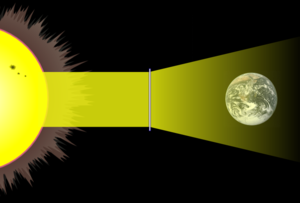Our website is made possible by displaying online advertisements to our visitors.
Please consider supporting us by disabling your ad blocker.
Space sunshade

A space sunshade or sunshield is something that diverts or otherwise reduces some of the Sun's radiation, preventing it from hitting the Earth and thereby reducing its insolation, which results in reduced heating. Light can be diverted by different methods. The concept of the construction of sunshade as a method of climate engineering dates back to the years 1923, 1929, 1957 and 1978 by the physicist Hermann Oberth.[1][2][3][4][need quotation to verify] Space mirrors in orbit around the Earth with a diameter of 100 to 300 km, as designed by Hermann Oberth, were intended to focus sunlight on individual regions of the Earth’s surface or deflect it into space so that the solar radiation is weakened in a specifically controlled manner for individual regions on the Earth’s surface.
First proposed in 1989, another space sunshade concept involves putting a large occulting disc, or technology of equivalent purpose, between the Earth and Sun.
A sunshade could potentially be one climate engineering method for mitigating global warming through solar radiation management, because internationally negotiated reductions in carbon emissions may be insufficient to stem climate change.[5][6] Sunshades could also be used to produce space solar power, acting as solar power satellites. Proposed shade designs include a single-piece shade and a shade made by a great number of small objects. Most such proposals contemplate a blocking element at the Sun-Earth L1 Lagrangian point.
Modern proposals are based on some form of distributed sunshade composed of lightweight transparent elements or inflatable "space bubbles" manufactured in space to reduce the cost of launching massive objects to space.[7][8] However it would cost trillions of dollars and no prototype has yet been launched.[9] Critics also argue that building it would be too slow to prevent dangerous levels of global warming.[10]
- ^ Oberth, Hermann (1984) [1923]. Die Rakete zu den Planetenräumen (in German). Michaels-Verlag Germany. pp. 87–88.
- ^ Oberth, Hermann (1970) [1929]. ways to spaceflight. NASA. pp. 481–506. Retrieved 21 December 2017 – via archiv.org.
- ^ Oberth, Hermann (1957). Menschen im Weltraum (in German). Econ Duesseldorf Germany. pp. 125–182.
- ^ Oberth, Hermann (1978). Der Weltraumspiegel (in German). Kriterion Bucharest.
- ^ Hickman, John (2018). "The Political Economy of a Planetary Sunshade". Astropolitics. 16 (1): 49–58. Bibcode:2018AstPo..16...49H. doi:10.1080/14777622.2018.1436360. S2CID 148608737.
- ^ Gorvett, Zaria (26 April 2016). "How a giant space umbrella could stop global warming". BBC. Archived from the original on 20 December 2016. Retrieved 7 December 2016.
- ^ Borgue, Olivia; Hein, Andreas M. (2022). "Transparent occulters: A nearly zero-radiation pressure sunshade to support climate change mitigation". Acta Astronautica. 203 (in press): 308–318. doi:10.1016/j.actaastro.2022.12.006. S2CID 254479656.
- ^ "Space Bubbles Could Be the Wild Idea We Need to Deflect Solar Radiation". Popular Mechanics. 7 July 2022. Retrieved 23 May 2023.
- ^ Surkes, Sue. "Israeli scientist proposes massive space sunshade to cut global temperatures by 1.5ºC". www.timesofisrael.com. Retrieved 16 January 2025.
- ^ Buckley, Cara (2 February 2024). "Could a Giant Parasol in Outer Space Help Solve the Climate Crisis?". The New York Times. ISSN 0362-4331. Retrieved 17 January 2025.
Previous Page Next Page


